Critics of proven conservation practices like no-till, strip-till or cover crop seeding often complain there’s no evidence of material benefits to a farmer’s bottom line — that the only thing that matters is yield.
But three different no-tillers from Iowa, Kansas and Ohio recently opened their books to illustrate how no-till and strip-till, cover crops, precision technology and refined nutrient management pays off in a big way.
Released in late 2018, the report, Farm Finance and Conservation, resulted from a collaboration between the Environmental Defense Fund (EDF), the agriculture managerial accounting firm K·Coe Isom AgKnowledge and farmers Scott Henry, Justin Knopf and Joshua Yoder.
It analyzes the impact of conservation on farm budgets by combining the farmers’ own records with their experience in adopting conservation practices. The cases show how they made conservation work financially and share lessons they’ve learned in the process of adopting conservation practices.
No-Till Takeaways
- Compile and study precision ag data from your farm, as it provides a feedback loop to help fine-tune conservation practices.
- Cover crops don’t have to be expensive. Seed just a single species or a few of them and you can still get tangible benefits.
- Herbicide costs could increase with no-till, but adding cover crops can reduce weed pressure. Keep interactions between conservation practices in mind.
LongView Farms embraces precision agriculture technology to most efficiently use fuel and crop inputs. The information generated by this technology measures the cost and efficiency of production practices and allows no-tiller Scott Henry to adapt those practices to maximize profits.
Raising corn and soybeans in central Iowa, Henry monitors climate data across all acres that he and his family manage. Every field has records of product used, field operations, yield and other pertinent data to provide feedback to farm managers and landowners.
GPS technology also lets Henry to improve seed placement, input application and harvest, in addition to reducing soil compaction and chemical and fertilizer overlap. He says these measures have increased yields, reduced costs and provided better stewardship of the farm’s natural resources.
LongView Farms uses forms of nitrogen (N) coming from NH3, 30% N, urea and sometimes ESN Smart Nitrogen, which has a polymer coating that slows the release of N to the crop. Henry applies fertilizer through broadcasting and ground incorporation, sidedressing or with drop tubes.
Henry’s farm practices no-till where applicable, depending on topography, soil type and crop rotation. The farm has also focused on cover crops, testing several different mixes and programs. Currently the farm uses a mix of oats and rye, which costs less than other cover crop options.
PRECISION CONSERVATION. Scott Henry says precision technology, split nitrogen applications and cover crops are making conservation practices pay on his Nevada, Iowa, operation, especially as precision data helps them track and understand the growing process. In 2016 he saw increased revenue of $7-$20 an acre for corn and soybeans.
Farmer: Scott Henry
Operation: LongView Farms
Location: Nevada, Iowa
Acres: 4,600
Crops: Corn, soybeans, sorghum
Practices: Precision technology, nutrient management, cover crops, mostly no-till, split N applications, slow-release N products, waterways
Programs: CRP, Unilever/ADM Sustainable Soy Continuous Improvement Program, Land O’Lakes SUSTAIN, research with Iowa State University and the Iowa Soybean Assn.
Henry’s target for cover crop seed costs is currently $8-10 an acre. Terminating the cover crop with herbicides costs an additional $8-12 per acre.
Henry says 2017 was the first drought year since his farm started seeing cover crops, and he reported fields with covers had higher water retention, which boosted yields in those fields.
According to Henry, the benefit of cover crops extends beyond soil erosion and is a vital tactic in fighting herbicide-resistant weeds. He feels covers provide better weed control on some acres than herbicides.
In Henry’s experience, this correlates to a yield increase of 1-2 bushels per acre in soybeans for increased revenue of $10-$20 per acre, and a yield increase of 2-4 bushels per acre in corn for an increased revenue of $7-$14 per acre.
“For LongView Farms, stewardship is more than tillage and production practices. Our family makes the collection of data, and tracking and understanding the growing process, a priority,” Henry says.

Doing the Math
A table of key financial variables (Tables A and B) summarizes Henry’s estimates of the magnitude of the cost and yield impacts from the farm’s conservation adoption. The table is based on a scenario of acres rotating from corn to soybeans, in which Henry plants cover crops for fall/spring growth and then no-tills soybeans into the covers the following spring.
All data is from 2016, so the corn and soybean acres aren’t additive on a per-acre basis. To calculate net impact, AgKnowledge summed the low and high end cost savings and yield impacts for each crop and then subtracted the high and low end increased costs.
For example, for the low end corn estimate, AgKnowledge added the low end cost savings and yield increase ($24+$7) and then subtracted the high end cost increase ($22) for a net impact of $9 per acre.
When key financial variables are analyzed, Henry estimates conservation adoption resulted in increased costs of $8-10 an acre for seed (for cover crops), $8-12 an acre for chemical to burn down covers.
But he also penciled in cost savings of $6-$14 for fertilizer; $4 an acre each for labor and fuel, $10-$12 for equipment rent and leases, for a total savings of $24-$35 an acre. This provided a net positive impact of $9-$32 per acre in corn and $12-$38 for soybeans.
Henry’s cropping budget for 2016 was also analyzed to measure any potential savings due to conservation adoption.
To enable comparison to other farms, it excludes the acres on which LongView Farms performs custom farming operations. Net return before land cost represents the gross income minus total expenses for each crop, divided by the acres of each crop.
Henry logged increased costs for seed and pesticides, but realized decreased costs for fertilizer, hired labor and machinery.

FEWER TRIPS. Gypsum, Kan., no-tiller Justin Knopf in 2016 estimates he realized cost savings of $5-$10 an acre for fertilizer, $15 per acre for labor and $5 an acre in fuel with his conservation program, which includes no-tilling, cover crops, precision technology and intensive crop rotation. Even though the net impact for all crops was a wash that year, he saw $40-$50 more per acre in revenue from his soybean crop and $10-$20 more for sorghum.
Farmer: Justin Knopf
Operation: Knopf Farms
Location: Gypsum, Kan.
Acres: 4,750
Crops: Alfalfa, wheat, grain sorghum, soybeans and corn (not in 2016)
Practices: No-till, cover crops, diverse rotation, nutrient management, precision technology.
Programs: CRP, Kansas State University research trials; on-farm research trials; research collaboration with No-Till on the Plains made possible by a Sustainable Agriculture Research and Education grant, and the Southern Plains Hard Wheat project with General Mills, ADM and Agrible.
Justin Knopf’s farm near Gypsum in central Kansas transitioned to 100% no-till in 2003, a change that he made to reverse the degradation of his soils, lower the costs of his operation and make his crop yields more resilient.
The farm’s no-till system requires a smaller fleet of tractors, fewer implements and lower-horsepower equipment. However, the replacement seeder and sprayer were more expensive, so his equipment costs remain near even.
But the change in equipment created a savings in fuel and labor because of the lower horsepower and reduction in tillage trips, requiring less fuel and creating less wear and tear on equipment. No-till systems also require fewer trips out to the field. Knopf estimates he does three to four fewer trips per crop.
Knopf says having a diverse rotation improves his soils and reduces financial risk. By planting multiple crops in the same crop year, he reduces the vulnerability of his full operation to volatile weather and price changes.
It’s not uncommon after fixed costs for Knopf to have a negative net return on a few crops each year, but the diverse rotation makes up for crops that don’t do well. In addition, a diverse system allows him to balance the farm’s workload and maintain less seeding and harvest capacity in his equipment because all of the farm’s acres don’t need to be harvested and planted at the same time.
Knopf also benefits from including a perennial alfalfa in his crop mix. He says it’s the most profitable cropping enterprise in his operation because its yearly variable costs are much lower, and alfalfa is resilient to poor weather.
Fixing Weathered Soils
Knopf has observed soil and yield improvements since the farm’s transition to no-till system with a diverse rotation. This is especially true for those fields more prone to erosion or having a higher clay content when planted with summer annual crops.
Knopf has measured improvements in the soil organic matter (SOM) of his fields from an average of 1.8%-2% prior to adopting no-till to an average of 3%-3.5% after adopting no-till.
While Knopf attributes some yield benefits to improved genetics in crop varieties, he also believes improved soil health from reduced tillage and his diverse cropping system also contribute to improved yields.
In particular, he notes yields are more stable during drought conditions. During droughts he’s seen fields looking healthy for 2-3 weeks beyond those of conventionally tilled farms, lengthening the window in which a rain can save his crop.
In the future, Knopf hopes to improve the biological activity of his soil by building up fungi that deliver phosphorus to the roots, thereby reducing his phosphorus (P) applications.
Knopf is also seeding cover-crop mixes on a portion of his acres. He’s still learning and fine-tuning where this practice makes the most sense within his cropping system. Knopf consistently seeds covers after the corn or grain sorghum rotation, ahead of planting soybeans.
He typically uses winter cereal combined with rapeseed or canola. After winter wheat, he also uses a mixture of millet, flax, sunflower, radish and turnip.
In selecting this mix, Knopf follows the theory that “diversity trumps quantity,” selecting a variety of species for their different benefits but applying them at a lower seeding rate to make the mix financially feasible.
Knopf says he worked with his seed provider to come up with a cover-crop cocktail that costs less than $15 per acre. He also sets goals for the benefits of his cover crops, such as testing whether his cover crop can allow him to eliminate an herbicide pass.
Knopf’s participation in the NRCS’ Conservation Stewardship Program (CSP) assisted him in adopting cover crops by reducing some of the risk in his early experiments. The CSP funds offset the costs of cover crop seed and seeding, which helps to absorb the financial impact of any errors as he fine-tunes his system.
Knopf has documented some added costs that have come along with the conservation practices. For a no-till system, he estimates he needs an average of two more herbicide applications per crop than in a conventional till system.
However, if he plants a cover crop, Knopf says herbicide requirements go back down to just one extra application. This shows the importance of considering the interactions between conservation practices and their potential to reduce costs, he notes.
From a financial standpoint, Knopf believes the next big opportunity is to incorporate the value of improved soils into higher land values – and thus an improved balance sheet.
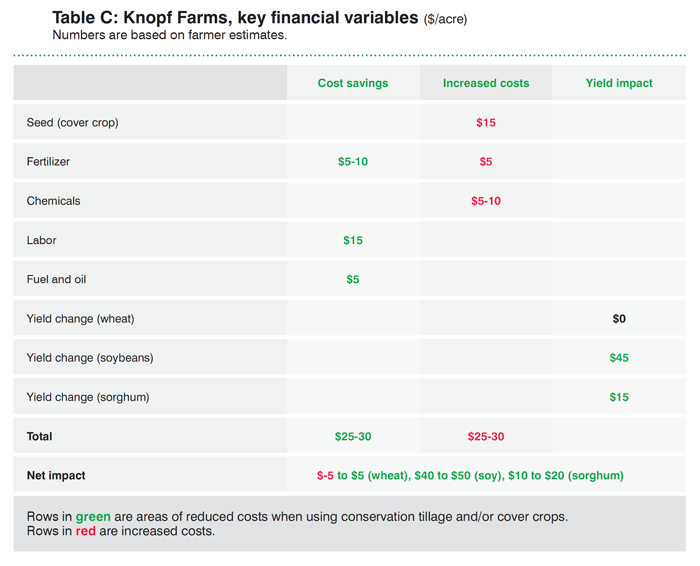
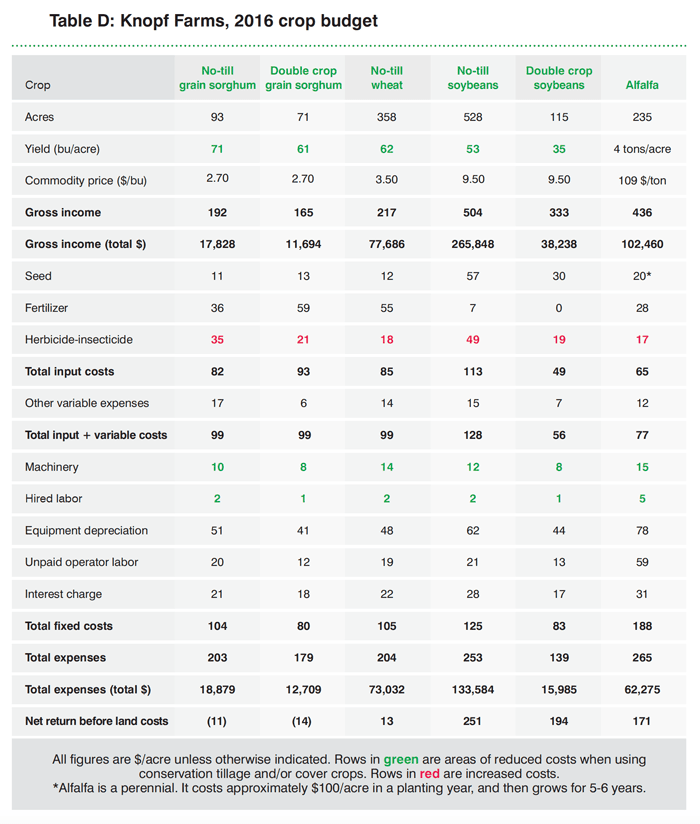
Pluses and Minuses
When estimating the magnitude of the cost and yield impacts of conservation adoption (see Tables C and D), Knopf found some good and bad in the figures.
Utilizing 2016 data, the wheat, soy and sorghum acres are not additive on a per acre basis. To calculate net impact, EDF and K·Coe Isom summed the low- and high-end cost savings and yield impacts for each crop and subtracted the high- and low-end increased costs.
Knopf Farms logged per-acre losses in 2016 on cover crop seed ($15), fertilizer ($5) and chemicals ($5-$10). However, he realized cost savings in fertilizer of $5-$10, labor at $15 and $5 for fuel.
Even though the net impact for all crops was a wash, Knopf says he did log $40-$50 more per acre in his soybean crop and $10-$20 more for sorghum.
When looking at his crop budget, Knopf saw increased costs for herbicides but reduced costs for machinery and hired labor.

FRUGAL COVERS. By shifting to mostly seeding cereal rye as a cover crop, Plain City, Ohio, no-tiller Josh Yoder cut his cover-crop program from $45 per acre to $22, but even with the more basic program he’s still seeing improvement in soil structure and health. He’s been surprised by the quality seedbed created by improved soil tilth, as the upward movement of the soil creates a good planting environment to improve the emergence and crop yields.
Farmer: Josh Yoder
Operation: Yoder Farms, Yoder Ag Services
Location: Plain City, Ohio
Acres: 1,800
Crops: Corn, soybeans
Practices: No-till, cover crops, crop rotation, nutrient management, precision technology.
Josh Yoder no-tills 1,800 acres of corn and soybeans with his father, Fred near Plain City in central Ohio. He also serves as president of Yoder Ag Services, which sells seed and precision technology to farmers and provides agronomic expertise to customers.
Yoder Farms is a 100% no-till and minimum-till operation, with the only tillage being a pass 1½ inches deep with a vertical-tillage tool to chop up corn stalks for residue management. Over the last seven years they’ve converted the unit into a cover crop seeder.
Josh and Fred started experimenting with cover crops by planting a three-way mix of radish, winter pea and crimson clover behind wheat in mid-August to get enough growth before the first frost. Through that experience, they saw a 2-5 bushel advantage in soybeans the year following implementation.
Despite the positive yield impacts, the costs for adding covers were substantial. The cost of the seed mix was approximately $35 per acre, and the application cost was $10-$12 per acre, which meant most or all of the yield advantage seen from fields with cover crops were absorbed by the costs.
Another challenge was time. Cover crops worked when planted after wheat in August, but in the Yoder’s region the growing season was too short for this to work with corn and soybeans, he says. When he stopped planting wheat they no longer used the original cover-crop mix.
Insights from Conservation Case Studies
Here are some insights that Environmental Defense Fund (EDF) and the agriculture managerial accounting firm K·Coe Isom AgKnowledge found through these case studies on no-till operations managed by Scott Henry, Justin Knopf and Josh Yoder.
• Conservation is a management system — the whole is greater than the sum of its parts. All of the farmers described conservation adoption as a transition to a new management system, rather than the implementation of isolated practices. They maximized the benefits of conservation adoption by focusing on how the different practices interact with each other.
• Technology and data provide feedback to fine tune management. Precision technology helped target the application of farm inputs like fertilizer and herbicides to reduce waste while maintaining or increasing production.
Whether information conservation practice performance was gathered by university experts, cutting-edge technology or their own observations, the farmers all adapted their management in response to that data. This feedback loop allows them to constantly improve their farming operations.
• Net cost of production decreased. Farmers in this report typically use a combination of no-till, nutrient optimization, cover crops and crop rotation on some or all of their fields. Acres under conservation tillage generally had lower fuel and labor costs due to three factors: fewer trips across the field, less intense use of equipment and transitioning to lower-horsepower machinery.
EDF and AgKnowledge estimated that transitioning from a 345-horsepower tractor costing $307,000 to a tractor of 195- or 280-horsepower tractor resulted in $33,000 to $93,000 in savings.
The organizations also estimated the savings from removing one tractor from production. With an average cost of $272,000 for the tractor, and a cost per year of $54,000 based on equipment life of 5 years, they estimated a farmer with 1,000-5,000 acres saves $11 to $54 an acre.
Josh switched to a cereal rye cover crop seeded behind harvested soybeans and corn, depending on the timing of harvest completion. Josh selected cereal rye because it’s the most winter-hardy crop he could find for their location.
Josh plants rye right behind the combine and lets it grow through the spring until it reaches 12-18 inches in height. He terminates the rye with glyphosate in April ahead of spring planting.
Josh says burning down the cover crop at this stage allows the planter to get through the field efficiently and preempts the growth of pests such as armyworms and slugs that could damage the following crop.
In addition to the logistical advantages of rye, the cost is much lower. Josh estimates he spends $5 per acre in seed, another $10 per acre in application costs and $7 per acre in added herbicide costs from burndown.
In total, Josh has cut the cost of his cover crop program in half, from $22 per acre with the cereal rye program vs. $45 per acre for his original setup.
Josh says he’s observed improvements in soil health and structure that he attributes to cover crops. He generally applies P and potassium (K) in the fall and the cover crop takes up and holds the fertilizer and pulls other nutrients in the soil up from the lower soil profile.
Josh says cover crops also reduce soil erosion and he’s seen crop residue break down more quickly due to greater microbial activity in his soils. This keeps nutrients available for uptake by the crop in the spring.
Josh has also been surprised by the quality seedbed created by improved soil tilth through seeding cover crops. By spring, he says, the upward movement of the soil creates a good planting environment, which helps improve the emergence of the crop seedlings and, ultimately, crop yields.
In the future, Josh plans to only apply fertilizer in the spring to minimize the risk of nutrient loss. At that time, the cover crop will primarily scavenge nutrients from the previous crop and prevent late-winter erosion.
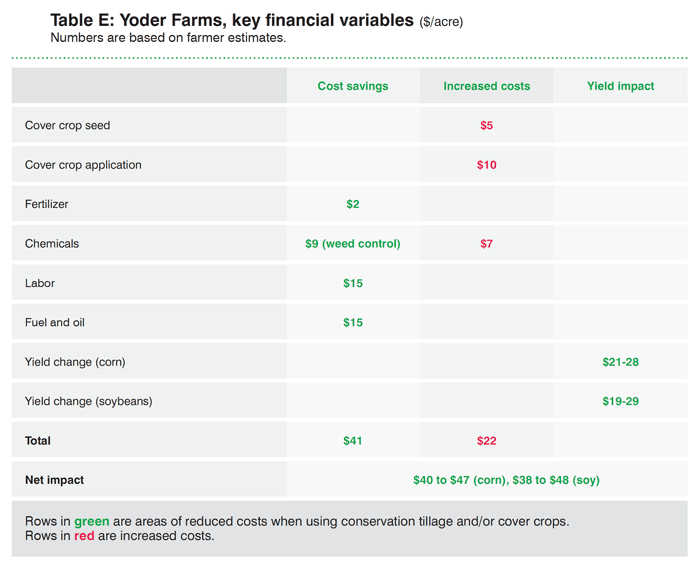
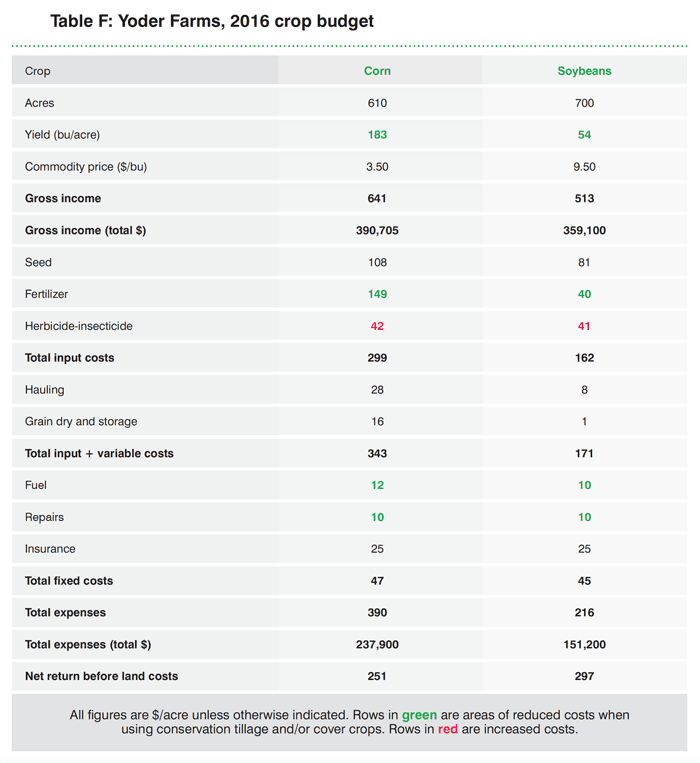
Going Green
As can be seen by the key financial variables, (see tables E and F) Josh Yoder estimates his cover crop program is saving him at least $9 per acre in weed control, and he’s seeing yield benefits of 6-8 bushels an acre for corn and 2-3 bushels for soybeans — resulting in a $21-$28 per acre revenue increase for corn and a $19-$29 per acre revenue increase for soy.
Adopting conservation practices increased costs for seed, application and chemicals, but like the other farmers he saw increased savings in fertilizer, labor, and fuel.
With cost savings and yield benefits combined, Josh has experienced a $40-$47 per acre benefit for corn and a $38-$48-per-acre revenue increase for soybean. These benefits significantly exceed the $22 per acre cost of his rye cover crop program. He also attributes cost savings in fertilizer, labor and fuel to conservation management.
Josh says his experience shows how conservation management, “must be fine-tuned to each farming operation in order to maximize financial benefits, and that trial and error can lead to big increases in profits.”







Post a comment
Report Abusive Comment